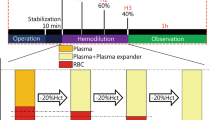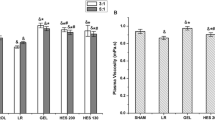Abstract
About twenty years ago, The National Academy of Science-National Research Council’s Committee on Plasma and Plasma Substitute, Division of Medical Sciences sponsored the Third Conference on Artificial Colloidal Agents. At that time there was some concern about the stability of dextran. Therefore there was the need for a more suitable artificial colloidal plasma volume expander. At this meeting the results were presented in order to evaluate the feasibility of using solutions of hydroxyethyl starch (HES). This polymer is a derivative of amylopectin, a “waxy” starch, containing only branched chains of glycoside molecules devoid of a linear component. It is prepared by first reacting the starch to acid hydrolysis and then with ethylene oxide in an alkaline solution. There are two distinct advantages to using HES as a plasma substitute. The first is the wide range of molecular weights that are available and the second is the degree of molar substitution, which is defined as the average nunber of hydroxyethyl groups reacted per anhydroglucose residue. It is this unique combination that is the major determinant for the rate of amylase hydrolysis and the time of retention. The half-life concentration parameter, that is, the time required for the concentration of HES in the bloodstream, following intravenous injection, to fall to 50 percent of its initial peak value, has a range of times from 24–36 hours for a weight average molecular weight, Mw, of 450,000 and degree of molar substitution, M.S., of 0.7 to 2–4 hours for a Mw of 40,000 and M.S. of 0.55, respectively [1].
Similar content being viewed by others
References
J. M. Mishler, Pharmacology of Hydroxyethyl Starch (Oxford University Press, New York, 1982) p. 36
R. P. Geyer, in Perfluorochemical Artificial Blood, edited by E. Hasegawa I.Kishimoto (Proc. Postcongress Symp., The Xth International Congress on Nutrition, Kyoto, Japan 1975) p. 3–19
L. C. Cemy, D. M. Stasiw, E. L. Cerny, J. E. Baldwin, B. Gill, Clin. Hemorheol. 2, 355 (1982)
L. C. Cerny, R. C. Graham, H. James, Jr., J. Appl. Polym. Sci. 11, 1941 (1967)
E. Misiaszek, R. Williams, D. Stasiw, L. C. Cerny, Biorheol. 14, 145, (1977)
L. C. Cerny, E. L. Cerny, M. E. Cerny, J. E. Baldwin, B. Gill, Crit. Care Med. 11 (9), 939 (1983)
G. W. Merrill, B. H. Koo, E. W. Salzman, J. N. Lindon, D. F. Brier, AIChE Symp. Series 74 (182), 90 (1978)
M. DeTraglia, F. Cook, D. M. Stasiw, L. C. Cerny, Biochem. Biophys. Acta 345, 305 (1974)
Author information
Authors and Affiliations
Rights and permissions
About this article
Cite this article
Cerny, L.C., Cerny, E.L. The Effect of Plasma Substitutes on Sedimentation Rates and Viscosity. MRS Online Proceedings Library 110, 107–112 (1987). https://doi.org/10.1557/PROC-110-107
Published:
Issue Date:
DOI: https://doi.org/10.1557/PROC-110-107




